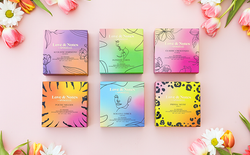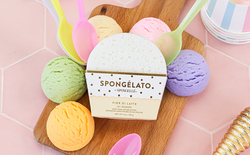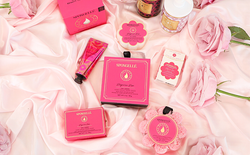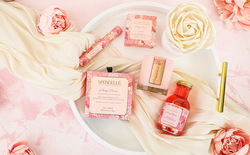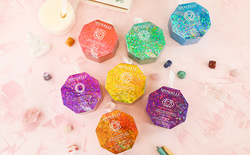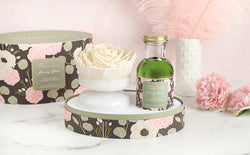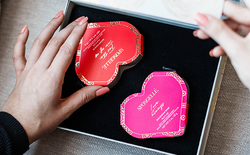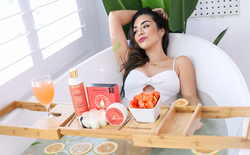Understanding your skin type is crucial if you want the healthiest possible skin. After all, you don't want to start spending money on skincare products that aren't meant for your skin. Skincare isn't one-size-fits-all since everyone has different needs.
If you're using products and not getting the results you seek, it may be cause the ingredients aren't meant for your skin type. Once you know what kind of skin you have, you can create a skincare routine that will work for you.
If you aren’t sure what skin types are or where to start, don’t worry! We’ll go over all the different skin types and how you can figure out yours.
Dry Skin Type
People that don't produce enough sebum have a dry skin type. Sebum is the oil your body naturally makes to help moisturize and protect your skin. If you have dry skin, your skin may look flaky, have a rough texture, and feel itchy.
Other factors may leave you with dry skin besides low sebum production. For example, you may have dry skin because of your environment. Low temperatures and dry air can result in dry skin. It can also result from certain skin conditions or vitamin or mineral deficiencies.
Dry skin types are often prone to irritation and even infections. When your skin is dry, your skin barrier can become compromised, allowing for these problems to occur. Proper care is essential to having healthy, smooth skin when you have this skin type.
Oily Skin Type
On the opposite side of the spectrum are oily skin types. Oily skin may constantly look shiny and feel greasy. People with oily skin often have overactive sebaceous glands. You can develop this skin type for many different reasons.
Some people are genetically prone to oily skin. If your parents had oily skin, you're also more likely to have this skin type. It may also be due to your environment. People often have oilier skin when they are in hot, humid places rather than cool dry places. Therefore, you may have oilier skin in the summer than in winter.
Oily skin types can also have acne-prone skin since the oil can mix with dead skin cells to clog pores. When your pores become full of impurities, pimples often develop. Treating your oily skin will be necessary to achieve a clear complexion.
You may feel like this is the worst skin type since it can result in breakouts. However, oily skin types normally don't show signs of aging as quickly as those with dry skin, and there are many ways to care for oily skin.
Combination Skin Type
Combination skin is a mix of dry and oily skin. You can either have both at the same time or fluctuate between seasons. Typically, people with combination skin experience oily T-zones and dry skin in the other areas of their face.
You most likely have combination skin if you notice that your skin is shiny in some areas and flaky in others. Similarly to the other skin types, genetics and the environment can play a role in combination skin.
You may also have overactive oil glands in certain areas of your face but not others. When you use harsh products that can contain skin-drying ingredients, you may also end up with combination skin. These products can send your oil glands into overdrive, creating an even oilier T-zone that leads to breakouts.
Sensitive Skin Type
Sensitive skin types are more likely to have an adverse reaction to a product or the environment. People with this skin type can experience redness, itchiness, or stinging patches of skin. They may also have frequent rashes without a known cause.
There are several reasons why people have sensitive skin. If you're wondering why your skin always seems to hurt, think about some of these causes.
- Contact Sensitivity: There is a skin condition that makes people more sensitive to irritants. When your skin comes in contact with something like a fragrance in laundry detergent or pollutants, it may become red and irritated.
- Allergies: Your sensitive skin may be a response to an allergic reaction. When you come in contact with something you're allergic to, like pollen, your immune system kicks into high gear.
- Dry Skin: When you have dry skin that you're not replenishing, it can lead to problems. Dehydrated skin is itchy and irritated and can put you at risk of developing more skin issues.
Normal Skin Type
This skin type has a healthy skin barrier and doesn't feel too dry or too oily. People with normal skin are not prone to blemishes or feeling shiny or tight.
Normal skin types generally have smooth skin without noticeable pores. They also aren't likely to have blemishes or sensitivities. However, this doesn't mean they never have skin concerns.
People with normal skin still need to follow a skincare routine to keep their skin looking its best. For example, even normal skin can get sunburned and develop dryness and flakiness if they don't wear sunscreen. Or if people with normal skin don't wash off their makeup before bed, they can still get blackheads.
自分の肌タイプを知るには
Using the descriptions of each skin type, you should be able to determine which one matches your skin. However, if you're still unsure of exactly what skin type you are, there are a few methods to try.
The Watch and Wait Method
This at-home method is done by observing how your skin reacts after cleansing.
- Wash your face using a gentle cleanser and then pat it dry.
- Wait at least an hour.
- Examine your skin and see if it's starting to look shiny or tight and flakey.
- Pay attention to where you feel oily. If you're only oily in your T-zone, you have combination skin.
- Any redness or irritation may be a sign of sensitive skin.
- If your skin remains the same, you probably have normal skin.
Blotting Sheet Method
Blotting sheets are very useful if you have oily skin, but they can also be helpful when trying to discover your skin type. Similar to the first method, wash your face with a gentle cleanser, dry it off, and then wait.
After an hour, press a blotting sheet over different areas of your face. Hold the sheet in place and press lightly. You have oily skin if the sheet absorbs a lot of oil. You may have dry skin if you only see little to no oil.
If you notice more oil in your T-zone and almost none in the other areas of your face, you have combination skin. You have normal skin if you see minimal oil on your blotting paper.
This method isn't great for determining if you have sensitive skin, but you can usually tell by redness and irritation. You can also consult a dermatologist for a professional opinion.
Skincare Routine for Your Skin Type
Matching your skincare routine with your type of skin will give you the best results. You have to know what to look for to select the best products for your skin.
オイリー肌
When you have excess oil already, the last thing you want to do is add more. Oily skin types should look for oil-free products. Wash your face with a gentle cleanser at least twice a day and apply a lightweight moisturizer. For blemishes, look for acne treatments with benzoyl peroxide or salicylic acid.
You may be tempted to look for products with harsher ingredients that can strip the oil off your face. However, stripping your skin could send your oil glands into overdrive, and you could end up with even oilier skin.
ドライスキン
It's all about adding hydration when you have dry skin. For your face, try a no-rinse cleansing cream. Avoid using hot water on your face or body, as it can strip your skin of its natural oils.
Moisturize twice a day, using a thicker cream at night to help replenish your skin. When bathing, use nourishing products, like a Spongellé body buffer. Our buffers are infused with body wash made with soothing ingredients.
The ideal time to moisturize your body is when you get out of the shower. Don't dry off completely. The extra water can be absorbed into your skin. Apply a lotion, like Coconut Verbena, all over your body (besides your face). It's infused with shea butter, jojoba oil, and vitamin E, perfect for replenishing dry skin.
混合肌
You want to follow a lot of the same tips for oily skin when you have combination skin. You can also try using a balancing toner and exfoliating with a mask.
敏感肌
You may have to go through a trial and error period before finding the right products for your sensitive skin. Avoid products that use synthetic fragrances, dyes, sulfates, and parabens. You can try a patch test to see how your skin reacts to a new product before applying it all over.
Spongellé products are made using vegan, cruelty-free ingredients. They don't contain any parabens or sulfates. Instead, they are formulated with natural plant extracts and essential oils.
普通肌
You don't have to do a lot when you have normal skin. Wash your face with a gentle cleanser and apply a daily moisturizer morning and evening. Every skin type can also benefit from applying sunscreen whenever they are in the sun.
Summing It Up
When you know what your skin type is, you can adjust your skincare routine to meet your needs. These skin care tips will help you achieve healthy skin that feels and looks fantastic. Spongellé has all the body products you need to help you get there, regardless of skin type.
ソース
Dry Skin: Types, Risk Factors, and Treatments | Healthline
Remedies for Oily Skin | Web MD
Sensitive Skin: Symptoms, Common Triggers & How It's Treated | Houston Methodist On Health
